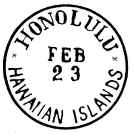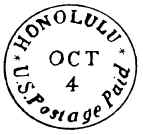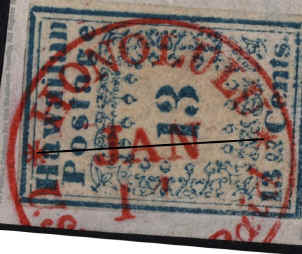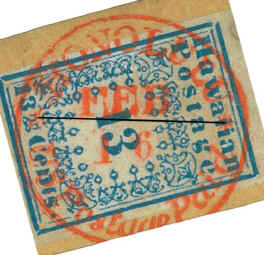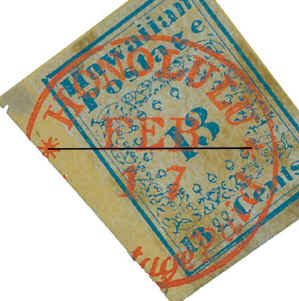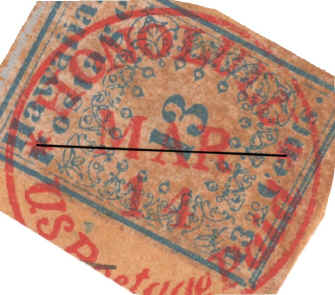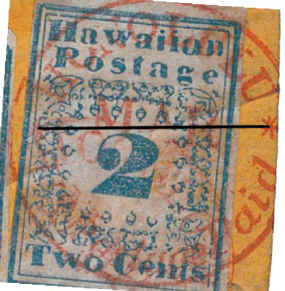|
Grinnell Missionaries |
|||||||||||||||||||||||||||||||||||||||||||||||||
|
Hawaii Postal History and the Grinnells (Richard Frajola, August 2, 2006) The following is an attempt to put the postal history of Honolulu in the 1850 to 1853 period into a proper context so that the Grinnell stamps, which are believed by some to have been used between January and March 1852, can be properly evaluated. The understanding of the postal system in operation at Hawaii at this time is a challenge given the lack of abundant postal artifacts and original documentation. However, it was a postal system. Mails were important to commerce and people living in Hawaii and an organized system was in place. Based on the information available, I believe that the systems used in Hawaii were closely patterned after existing systems in place in the United States. Information about the rate structures in effect during the period is well documented elsewhere (see Fred Gregory Hawaiian stamp website here). It is convenient to commence this study with the introduction of the first Honolulu postmark in 1850. The Post Office in Honolulu was officially established by a Decree signed on December 20, 1850 by the Prime Minister and King Kamehameha (Meyer - Harris, pages 14-15). A straight line Honolulu postmark was used before the post office was established. Prior to December 20, 1850, it is known struck in blue, and from that date it was struck in black, the latest reported usage being June 14, 1851. Henry M. Whitney served as postmaster and the post office was located in the newspaper office of the Polynesian. According to Meyer-Harris (page 97) Hawaii authorized postmaster Whitney to print stamps on June 18, 1851 but the new Decree was not to go into effect until published in the Polynesian where it was duly published on September 13, 1851 along with a new schedule of postal rates. Also according to Meyer-Harris, three stamps (2 cents, 5 cents and 13 cents) were placed on sale on October 1, 1851. A notice in the October 4, 1851 issue of the newspaper announced the three stamps and mentions four other items that are particularly important: 1.) Regarding mails to and from
San Francisco: 2.) Regarding mails to and from Lahaina: "The regular mail for Lahaina is made up every Tuesday and Friday, closing at 4 o'clock p.m., and in returning, leaves Lahaina every Monday and Thursday evenings. 3.) Regarding the availability of stamps in other offices: They will be found convenient to persons residing on the other islands, and will be at any time be accepted, when returned to the office. Postage stamps can be procured of S. Hoffmeyer, Esq., Postmaster for Lahaina. 4.) Regarding the hours of operation: "Hours for delivery of letter - from 9 A.M. till 4 P.M. In case of the arrival of a U.S. mail on the Sabbath, the office will be opened at 3 P.M., and remain open for delivery of letters, 15 minutes only" Honolulu Post Office Patterned after Post Offices in the United States This announcement corresponds both in form and in content to similar announcements of postal operations in the United States at the time. For example, compare item four above with Section 50 as found in Postal Laws and Regulations of the United States of America, 1852, from an Act passed in 1825: "The postmaster will keep his office open for the despatch of business, every day, except Sunday, during the usual hours of business in the place; and attend at such other hours as may be necessary to receive and despatch mails." Item number one above is similar to announcements made by the San Francisco postmaster. Sections 63 to 65 of the same 1852 Regulations are particularly informative: "Sec. 63. Letters received to be sent by mail. should be carefully marked with the name of the post office at which they are received, and the abbreviated name of the State or Territory, the day of the month on which they are forwarded in the mail ....." Sec. 64. At offices where there is much business, the work of rating and marking should be performed as fast as the letters are received, and not left until the time of closing the mail, when in the hurry of business many errors may be committed. Sec. 65. Letters, however, must bear post-mark, and post bills must bear the date on which the mail containing them is actually sent off, although they may have been made up on a previous date." The system of handling mails outlineb by these Regulations was almost certainly adopted in Hawaii from the introduction of the straight line postmark in 1850. The census of known covers from Honolulu dated between January and July 1851, although a small sample, shows 23 covers that bear a total of only 12 different dates. Each date represents the date of the intended sailing of a vessel to San Francisco. The amount of time between postmark dates varies but is, at a minimum, seven days. None of the postmark dates are Sundays. As in the United States, mails were made up in advance of ship sailings and were postmarked with a date of the intended onward transmission. It is possible that ships did not depart on the scheduled date, or that dates published for departure were erroneously reported. Items numbered two and three in the above Honolulu announcement above are included because they deal with a regular, contracted mail service to the second largest town in Hawaii at the time. Similar to announcements of contract service in the United States, item number two includes the regular schedule for mails to and from Lahaina. This was not a random service, nor a daily service, it was regularly scheduled so that correspondents could anticipate mail arrivals and departures. Item number three lists the Lahaina Post Office and Postmaster as an alternate source for the missionary stamps. No mention is made of any other sub post office. I read this as implying that only stamps purchased at Lahaina or Honolulu could be used from other locations in Hawaii. These stamps could have circulated to other outlying locations after purchase. Honolulu Postmaster Whitney Orders Postal Devices Postmaster Whitney's copy of
a letter written to J. W. Gregory, of Gregory's Express in San
Francisco, dated May 22, 1851 survives in his letter book at the
Hawaiian Archives. A transcription of the letter appeared in the Frederic
A. Wheeler's article "The Honolulu Straightline and Its Historical
Background" (see bibliography) on page 28: Below are rough tracings that are similar to those that may have accompanied the above letter of instruction. Tracings numbered 5 and 6 are speculative.
Style No. 1 was intended to be used on mail for which only the Hawaiian Islands letter postage had been paid. Style No. 2 was to be used when both Hawaiian internal postage as well as United States postage had been paid. Although type No. 3 was intended to be used for newspapers according to the order, it is found on covers where additional United States postage was prepaid to show the amount of that additional postage. Style No. 4. is found on newspaper wrappers, on covers with U.S. postage paid in cash, and as a cancel. Styles No. 5 and No. 6 are found used only as cancels on stamps. From the census of known covers as compiled by Fred Gregory and summarized on his Hawaiian Stamps website, there are three reported minor types of marking #1 (an additional fourth type used in 1864 was recently discovered as well) and three reported types of marking #2. The known dates of use show that the three different devices of each style were used sequentially. This information is summarized below.
This pattern of use indicates that the intent of postmaster Whitney was to hold in reserve the duplicate devices ordered until they were needed. Had any of the four devices been sent to another office, there would be overlap in the usage dates. It should also be noted that had Whitney wished any other office to have a set of devices, that office would have been Lahaina because that was the other office that was authorized to sell stamps. The earliest reported usage of a cover bearing stamps canceled by marking No. 5 is postmarked on September 11, 1852 and the latest usage is October 16, 1852. The earliest reported usage of marking No. 6 on cover is postmarked September 10, 1853 and the latest is postmarked on October 20, 1853. Again, this show sequential usage of obliterators. As will be seen, the relatively late adaptation of marking No. 5 as a cancel may indicate that Gregory was unable to fulfill the Whitney order in a timely fashion. The Early Missionary Covers This brings us to the early period of introduction of the missionary stamps. The earliest reported usage of a missionary stamp on cover is a letter dated January 3, 1852 (a Saturday) from Lahaina (this letter has been reported as being dated December 31, 1851 in previous literature but it bears an additional internal date of January 3). This cover bears a fragment of a 13 cent stamp, pen tied, and has no Honolulu postmark. It does bear a San Francisco February 18 postmark reflecting the date it was forwarded by steamer to Panama. This letter could have been carried by either the George Washington that departed Honolulu on January 18, 1852 or by the Honolulu Packet which departed on January 17, 1852. Both vessels arrived in San Francisco on February 17, 1852. Both ships stopped at Lahaina after departing Honolulu. Interestingly, a November 1, 1851 letter from Lahaina, quoted by Carl Walske and Steve Walske in the Collectors Club Philatelist, Vol 85, No. 1. page 22, mentions: "our clipper packets Kaluna and Maria are very regular in their trips: the former leaves Honolulu every Tuesday & leaves Lahaina every Thursday - the other leaves Honolulu every Friday & Lahaina every Monday." This is exactly in keeping with the announcement cited above (item #2). The schedule was evidently maintained on this service as an additional letter from the same correspondence, dated January 2, 1852 from Lahaina mentions the same service. The above shows that the scheduled regular service from Lahaina to Honolulu was in operation when the letter bearing the missionary stamp was posted in Lahaina. As a result, this letter would have been sent along from Lahaina to catch a steamer from Honolulu to San Francisco either by the packet departing Monday, January 5 or Thursday, January 8, 1852. As the stamp is pen canceled, and their is no Honolulu postmark on it, I conclude that Honolulu post office had not received their devices prior to the departures on January 17-18, 1852. The other reported missionary covers dated prior to the introduction of cancel device No. 5 on September 11, 1852, are also worth examining. The February 20, 1852 Dawson cover that bears a strip of three 13c is cancelled by the so-called "sugar cane" cancel, obviously a provisional device. Other covers either have uncanceled stamps, or stamps canceled by one of the existing postmark devices (either style #2 or #4).This clear pattern of use of cancels at Honolulu indicates that Whitney did not receive cancel device No. 5 at the same time as the postmarking devices. I think one possible explanation for this is worth consideration. The letter from Whitney to Gregory in San Francisco states that the postal devices were to be procured "in New York or where they can be obtained most reasonably." Gregory probably would have had access to several different manufactures of postal devices at this time that he might have considered to be more reasonable to use. As he was engaged in the express business himself, and used devices of mixed type styles (normal and italic letters) such as those used at Honolulu, I suspect that he relied on one of his normal suppliers to fill Whitney's order. These postmark manufacturers to the express companies did not have to worry about making cancel devices in 1851 as stamps were not used by the companies. Also, the "teak handles" requested by Whitney might have entailed special consideration on the order. Both cancel styles No. 5 and No. 6 are similar to post office cancels employed by post offices in the United States. It may well have taken Gregory longer to fill that portion of the order. It should be noted that during this period no examples of postmarks used other than at the town designated in the postmark are known. The Honolulu postmarks were used on mail that was posted at that office, or on mail that was received at that office having been sent there for onward transmission for outlying offices. The Cancels and Postmarks found on Grinnells An examination of the postmarks and cancels that are found on the Grinnell stamps, taken in the context of the postal history as outlined above, is in order. These items must be evaluated impartially based on comparison with known genuine examples found on covers. The Cancel Ink Found on the Grinnells During the 1851 to 1856 period, and beyond, the United States post office proscribed the ink composition to be used in canceling stamps. That composition included black or red printer's ink which was mixed with varying small amounts of linseed oil and placed on a porous pad, often of cuttlefish. The resultant postmarks and cancels, particularly those struck in black, have an distinct appearance which to a trained eye is very different from cancels struck with ink that has been mixed with water rather than oil. Not to dwell on this subjective point, the cancels and postmarks found on the Grinnells do not match in appearance the ink/oil formulation found on genuine stamps or covers of the period from either Hawaii or the United States. The Cancels and Postmarks Found on the Grinnells There are three principle styles of cancels found on the Grinnells. The first is similar to the genuine type No. 1 as shown above, another is similar to type No. 2 shown above and the third is similar to cancel No. 5. By consensus, everybody agrees that the postmarks of types 1 and 2 that are found on the Grinnells do not match in form any of the genuine types reported on stampless or stamped covers. The Grinnell stamps bearing type No. 1 or No. 2 postmarks will be examined first. Eleven different readable postmark dates are reported as being from 1852, each is reported on only a single item. The dates reported are January 5,11,14, and 17; February 1, 5,16 and 17; March 1,14 and 15. It will be noted that all of these dates can be composed using but 5 different digits (1,4,5,6, and 7) and just three different month slugs. The range of the dates is between January 5 and March 15. During that period there are 70 possible dates. Of those, 29 can be composed using the five Grinnell digits while 41 can not be. The probability that 11 distinct dates, chosen randomly from the possible 70 in this period, are missing all of the digits 2,3,8,9,0, is less than .000016 (1.6 per hundred thousand). What seems more probable is that someone using photographs of drawings to compose the date portion of the postmark, selected but three different months and five different digits to make their devices. Another important point regarding the dates found on the Grinnell postmarks is that three of the dates are Sundays: January 11 on #G64, February 1 on #G70, and March 14 on #G40. This is not consistent with the way that postal operations in Hawaii were conducted as the announcement above clearly states that the office was closed on Sundays except for the delivery of arriving mails. Although mail steamers may have arrived in Honolulu on Sundays, they would not have normally scheduled departures on the Sabbath. And finally, in regard to the Grinnell postmarks, the variations found in the date portions of the markings are not compatible with strikes having been made by postal devices with removable date slugs. The hand-held postmarking devices in use throughout the classic period in the United States and in Hawaii, both those in wood and those in metal, were basically the same structurally. The device had an outer raised rim, raised lettering around the perimeter, and a central, rectangular cavity which held "plugs" for month and date inserts which were separate. These month plugs were sized to match the width of the cavity very precisely so that they could be changed and tightened into place. Although some slippage is found in marks produced by such devices, it is usually very minor and always in the vertical direction as the set screws for tightening may not have been adequately set. This usually takes the form of a dropped numeral of the day. However, angular twisting of the slugs is not physically possible within the horizontal constraints of the cavity. It is not that a single marking can't show angular tilting when measured against a horizontal dividing line. This could occur if the rectangular cavity was improperly placed. However, all strikes made by that device would show a constant angle of offset. The "Honolulu U.S. Postage Paid" postmarks found on the Grinnells are shown below. A black line that connects the central point of the two side stars in each postmark have been drawn in black. In addition to the substantial vertical variation found where the line goes through the month, there is evidence of angular twisting to an extent that is impossible for it to be consistent with a postal device of the era. Stamp #G13 shows a counter-clockwise tilt and two others show a clock-wise tilt of the month. My conclusion is that these were not made by a postmarking device. However, these findings are consistent with postmarks that were made from a composite photographic image where the month and day were inserted by hand each time.
|
|||||||||||||||||||||||||||||||||||||||||||||||||
Thanks to David Handelman for the probability calculations used above as well as to Dick Celler for providing me with the transcription of Whitney's request for devices that was published in AP.
Addendum, August 8, 2006: Dick
Celler has informed me that there are five postmark dates found on the
Grinnells that were missed in the above discussion - these are JAN 7 (#G43),
JAN 16 (#G78), MAR 7 (#G46), MAR 1 (#G47) and MAR 5 (#G55-59). The probability that
16
distinct dates rather than the 11 above, chosen randomly from the possible 70 in this period, are
missing all of the digits 2,3,8,9,0, is less than 2.74 x 10^(-8)
(.00000002736..) (after rounding), about 2.7 in a hundred million (thanks to
David Handelman again).
back to main Grinnell index page
Richard Frajola (August 2, 2006)



